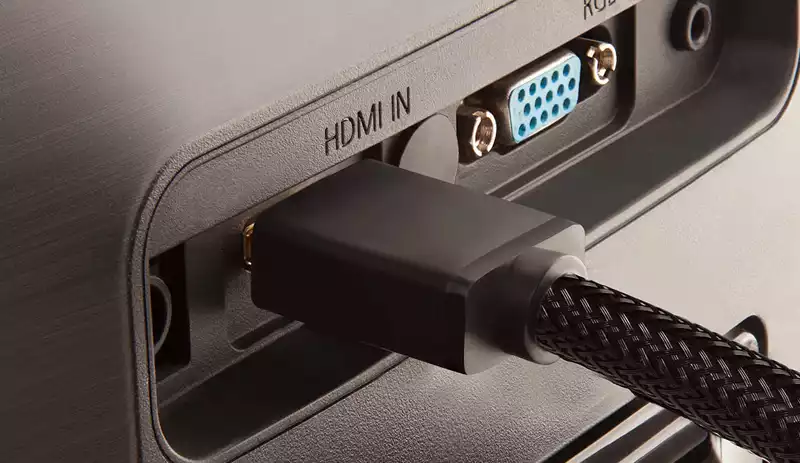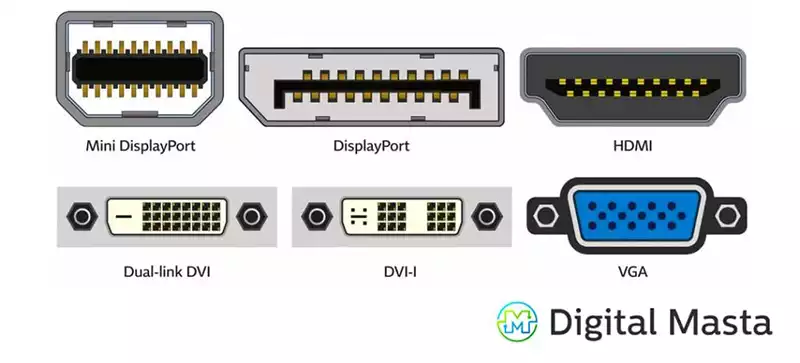You can also be interested in these:
- Do you need a PC for a monitor to work properly?
- Types of projection displays for a car
- AMD FreeSync vs FreeSync Premium vs FreeSync Premium Pro
- Can HDMI be converted to USB?
When you’re dealing with high-quality video and audio that you don’t want to be modified or compressed in any way so that you can experience it exactly as intended and use the full features of your external device like a big screen TV, then you need to understand which computer port transmits audio and video without the need for compression?

Historically most video outputs from your computer to a TV, monitor, or other devices were VGA, but the new and better port that provides uncompressed audio and video together is HDMI.
Assuming your computer and external device are not extremely old, then both should have an HDMI port to transmit audio and video without the need for compression.
Follow along as we go through some of the intricacies of the HDMI ports that may impact your use of it, especially if you’re using a slightly older computer for transmitting the audio and video.
Is HDMI all I need to transmit audio and video with compression?
HDMI ports can transmit both audio and video without any need to compress the data. The data you send will not be altered in any way, so if you have high-quality audio and video files to transmit for commercial purposes, you want the best quality for your home entertainment system, or you want to ensure your specialty audio with binaural beats gets played as expected then HDMI is what you need.
However, there can be problems, such as cheap HDMI cables that are too slow to transmit data effectively, especially over longer distances. Your other issue will be the receiving device and whether it can handle the format and quality that you’re sending.
Just because your HDMI port can send the data, external factors can limit the benefits you get, so it’s important to understand what you should be using and whether you’ve got an external device that will benefit from uncompressed audio and video data.
So, ensure you check several things:
- Can your external device handle the audio or video format and quality you’re sending? Check your owner’s manual or online to see what is possible.
- Is your HDMI cable good enough quality for the quality you’re sending, which is the speed rating of the cable, and will it be able to handle the length required? Poor quality cables or older cables may have issues with high-quality data at long distances, especially over 10m, and HDMI, in general, may have issues over 40m.
If you find issues with the quality over long distances, but you have an expensive, highly rated cable, you may need to add repeaters or amplifiers.
Are all HDMI cables the same?
When determining which computer port transmits audio and video without the need for compression, you’ve determined that it’s the HDMI port, but the cable used can cause issues.
We discussed that cheaper cables could have a low-speed rating, meaning that a huge amount of data will be slow to transfer over the cable, especially over long distances. However, the other issue you can face is the HDMI cable version you are using because different versions support different audio and video formats.
You’ve got the older versions such as HDMI 1.0 and 1.1, which only support up to 720p and 1080p at lower refresh rates. So, if you’re hoping for maximum video quality from 10K video with high refresh rates, then you need an HDMI 2.1 cable with a high-speed rating.
In contrast, most HDMI versions support all modern audio formats, so it will just be the speed rating and length of the cable that may cause audio issues.
Are HDMI and DVI compatible?
HDMI is backward compatible with DVI with the exclusion of DVI-A. The issue you will face is that DVI is only video, so you will need to transmit audio via another method.
If you’re concerned about audio and video quality but are still using DVI on your receiving device, then you may want to consider upgrading your device to get the full benefits that you’re looking for.
You can even get HDMI to VGA cables for ancient devices, but they have the same issue of no audio being received by the VGA plug.
Is HDMI the best option?
Determining if HDMI is the best option for you will really depend on what you’re using it for and what you’re connecting to. Just because you can use an HDMI cable and you’ve heard that it’s the computer port that transmits audio and video without the need for compression doesn’t mean you actually get any benefit out of using it.

HDMI will be the best option for high-quality video and audio transmission that you don’t want to be compressed, assuming that your HDMI cable is high quality, and your receiving device can handle the format you’re sending. You will need to check both to see if it’s a good option for you.
If you’ve purchased an expensive TV that offers super high-definition video and you want to get everything out of that TV, then HDMI will really be your best option. Using Wifi to transmit may have limitations on the receiving Wifi connector.
There are also limitations on the audio that many receiving Wifi devices such as Chromecast and Roku can handle, so things getting the most out of your audio will require HDMI.
When Is HDMI not the best option?
The downside to HDMI is that it requires a physical attachment between devices and has a limited range before the quality starts to drop, or you need to add repeaters or amplifiers. So, adding a long cable along the ground or through your wall may be added work for no benefit.
If you’re streaming Netflix from your computer to a TV that can only handle 720p, then you may be better off using an alternative option like a Chromecast or Roku device, which removes the need for the physical cable, and there are no distance requirements. Most wireless devices can handle good quality audio and video; it’s only the highest levels that will require a physical HDMI cable.
More stories like this
- Do you need a PC for a monitor to work properly?
- Types of projection displays for a car
- AMD FreeSync vs FreeSync Premium vs FreeSync Premium Pro
- Can HDMI be converted to USB?
- What is the difference between TAA vs FXAA?
- Can a monitor work without a PC attached to it?